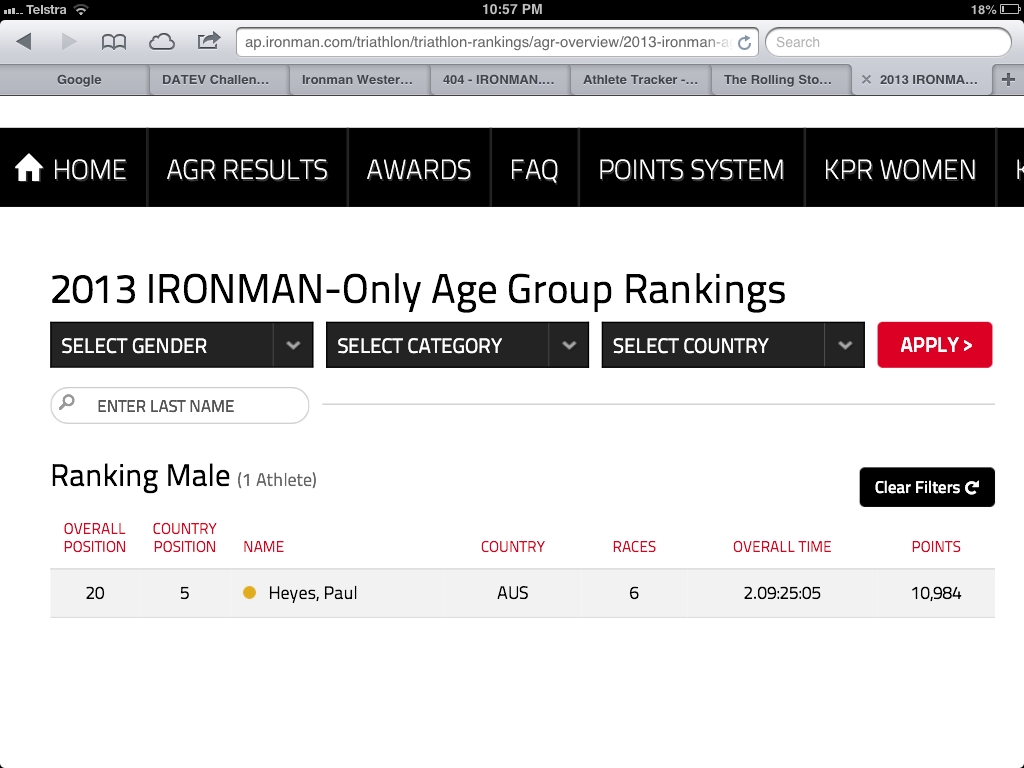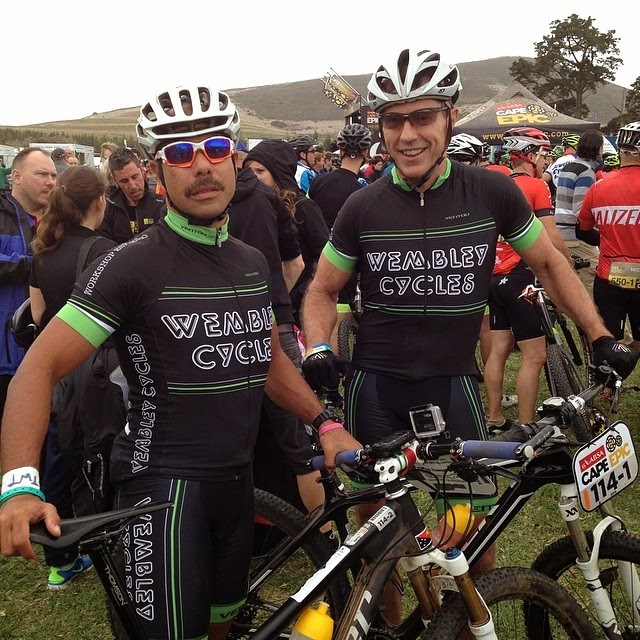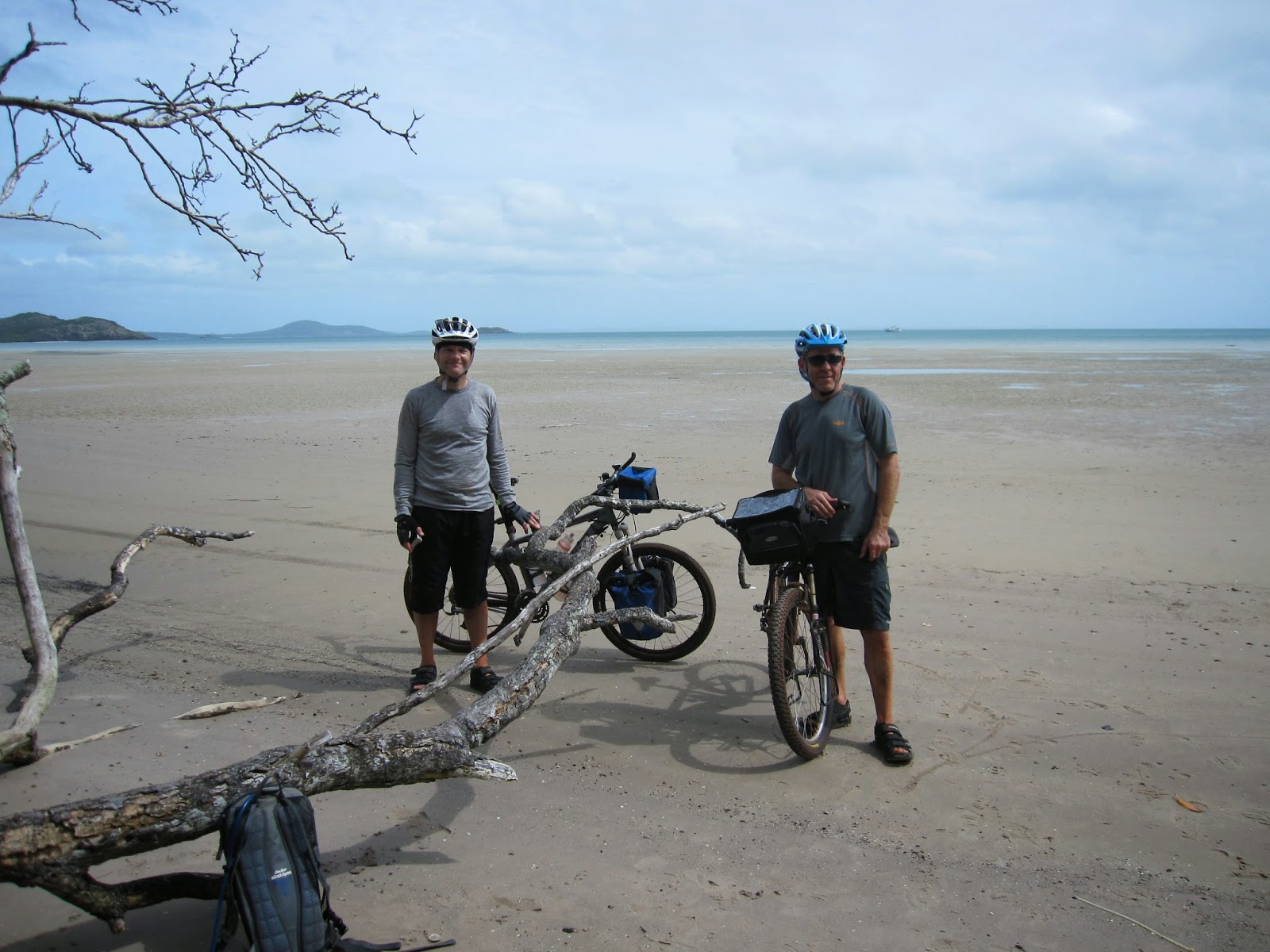Eventually, the completion of the 2013 blogs. It has been nice to have had positive feedback, not only from a surprising number of people, but from a wide range, many who have no interest in triathlon, and actually asking if I was doing another blog.
Blog 10 is now finally submitted following a request to do a write-up for the annual North Coast newsletter. Sorry Michelle, but 300 words . . . no chance! The edited version can be seen in the newsletter, but now the rest is down on the computer I can upload the more indulgent version.
BUSSELTON IRONMAN, DECEMBER, 2013
My 4th Ironman in less than 6 months! Despite less than impressive performances so far, Gilly Chutrau informed me that I was in the Top 1% of all international Ironmen. With athletes’ best 3 races counting, a strong race in Busselton would put me inside the 2013 Top 20. Surely, that is an achievement worth striving for.
Or is it? From the perspective of a normal human being, is being in the top 1% of self-obsessed, pro-athlete wannabes, with skewed priorities, and more money than sense, really something to shout about? Furthermore, just how many other people are daft enough to do 3 Ironman races, or more, in a year?
 Forgetting these questionable personality traits, just how good is the Busselton Ironman? A truly magnificent location, excellent host town, impeccable organisation, and this year, for the first time in a while, moderate temperatures with not much wind. Perfect!
Forgetting these questionable personality traits, just how good is the Busselton Ironman? A truly magnificent location, excellent host town, impeccable organisation, and this year, for the first time in a while, moderate temperatures with not much wind. Perfect!
The iconic jetty swim has to be one of the best on the global calendar. Clear water all the way, and incident free. I was surprised and delighted to see I had done a 1'13" PB. A mere 20-odd minutes behind Blake Kappler, and a massive 35 minutes quicker than the swim I did in Zurich 4 months earlier. Thanks to Arron Robertson, Paul (Swim Smooth) Newsome, and Matt.
Smooth ride
A typical, leisurely 7 minutes in T1, and then out on the bike to try and achieve my only real goal of the race - a sub-5 hour bike ride. The limiting factor is usually my back. Spasms practically destroyed my Kona race, and my riding is always compromised to some degree, leaving me apprehensive. Tightness and pain in the car on the way down was not a promising sign. Yet, on race day, amazingly, for the first time ever, no back issues at all.
 |
| Easily distracted! Losing concentration on the last lap. Photo courtesy of Dennis Tan |
concentration for a few km, and with it some momentum, I slipped off the pace. Consequently, the last 7 or 8km had to be done with much more effort than I have ever used in my 12 previous Ironman races. With 2km it was going to be down to the wire. The last kilometre was a sprint. I had absolutely no concern regarding the impact this silly, unsustainable effort would have on the subsequent run. I had been nursing a hamstring injury, so was not confident of a sub-4 hour marathon. Hence, the only thing I was bothered about was a decent bike split. After taking chances on the last few corners I stopped the computer at 4 hours, 59 minutes and a few seconds. Brilliant!
Except, as I was gutted to discover later, it wasn’t! Well, not according to the WTC. Their timing mats are a few metres before/after the mount/dismount area where I started and stopped my computers. So, sadly, my official bike-split was a few seconds over 5 hours. Well, bollocks to that! Discounting the Gold All World Athlete Status WTC marketing bullshit, I don’t have any triathlon achievements to shout about, so I was, most certainly, claiming this one. Using indisputable supporting evidence and data from the US GPS system, Sputnik, my two Garmins, and Strava, the fact is I did, indeed, cycle just over 180 km, or 112 miles, in less than 5 hours, at an average speed of 36 kph and won’t be letting anyone state otherwise, thank you!
After doing a bit of stretching it was almost 5 minutes in T2. Starting the marathon is always a great unknown. You are never really sure how the legs will function until you have run a few metres, regardless of how you feel at the end of the ride. How would the legs be today, after the foolish effort just done? Weird! They felt better than they had ever done at this stage of the race. For me, the four 10.5 km laps help psychologically. The thought of a 42.1 km marathon with an already fatigued body can be a mental burden. But forgetting the kilometres, and thinking of it in terms of “just” 4 laps, easy! For some reason, on this particular day, it actually felt quite pleasant.
It is hard to explain how this can be possible, but probably has something to do with the magical Ironman vibe of Busselton, and the amazing volunteers who make it all happen. On the run, in particular, the support was fantastic and uplifting. The Tri Clubs provided a real boost. As usual The North Coast area was particularly impressive - noisy and encouraging, with huge numbers spurring us all on.
Loud and proud
The Exceed Tri Club was prominent too. In addition to their visible and vocal support on the bike leg, which broke the monotony of the forest, Exceed were also loud and proud on the run. Their sledging was original, and witty, led by Rod Marton and Meredith Douglas. I had the pleasure of being an Iron Spectator alongside Meredith a few years ago, and was entertained by her humorous observations regarding packages and appendages. Remembering this, as I ran past, I was thankful that Busselton is not cold in December.
Not far into the second lap things took a sudden turn for the worse. Feeling good, I foolishly upped the pace, even doing a couple of sub 5-min kilometres. Relaxed, in the zone, fantastic. Until, suddenly, the inevitable happened. Ping! Hamstring! Shit! Was I prepared to walk for a few hours just to get a medal and finishers towel? Time to come up with a Plan B.
This was to try out the methods of the “Doctor of Weird Shit” (which incidentally also carried Chris Balde to an impressive sub-11 race following injury). I spent a few minutes putting the good Doctor's somewhat less orthodox advice into practice, had a couple of salt sticks, then started striding for a few metres. There was still pain and tightness, but it was manageable. Then slowly into the Ironman shuffle, with quick, short steps. All this happened at the Aid Station just west of the crowds and jetty. I got strange looks as I bent over to stretch, and then start rubbing my leg with one hand, whilst placing the thumb of my other hand on the roof of my mouth. Well, whatever works, and don't knock it till you try it. Eh Chris.
So, things were OK for now, but how long until it went completely? It ended up being a strange run. Having to jog slowly to protect the injury, it was the easiest marathon I have ever done. Just increasing the stride length slightly sent sharp warnings to my brain to desist. I can't remember ever doing a marathon where I did not have to fight the urge to walk. But on this day, not even that. It was stressful though, because there was a constant fear that the next stride could be the last, and the hamstring would say no more. But of course, this is the same for so many athletes on the run leg, as the fatigue sets in and body salts get depleted.
The last lap was actually enjoyable. I was beginning to realise that even if I had to slow down, or worse, forced to walk, I could still complete the run in less than 4 hours, and, amazingly, achieve something that was not even on the radar: a sub-10'30" Ironman. In fact, it ended up being 10'17". A PB by around half an hour! Who would have thought it? I certainly didn't.
 |
| Hills ride: Bill's squad getting the foundation winter miles in before the real training begins |
Blake Kappler went sub-10 after waiting at the side of the road forever to have his bike mended. Without the tyre issue, what could have been? There was also a great comeback by Nino Fabris. Despite throwing himself on the floor during the bike leg, at great speed, Nino only just missed the 10-hour mark. All those training rides past the Gravity Centre, yet Nino chose this day to challenge its laws.
After the arrival, in September, of their daughter, Mikey McConnell had to forfeit the opportunity to take on the world in Hawaii. It was especially good to see him at the pointy end of the field again, finishing with a time in the low nine hours. Brilliant! More importantly, Mikey claimed his second, elusive Kona spot, which, all being well, he can use to fulfill his dream, and potential, later in 2014 with his new family alongside.
Gilly and Billy
And then there was Mr Guillermo Chutrau! None of this: "I can't do the Aquathon/10k/Hills Ride/have a few drinks in the pub” nonsense, because “it is not in my program". Gilly just does it all, does it exceptionally well, and continues to smash PB after PB, whether in a triathlon, a running race, or a Time Trial (averaging over 40kph at Champion Lakes). He has also qualified for two world championships: the 70.3 in Quebec, and a few weeks later, Kona. Gilly’s time here? I can't remember exactly, except that it started with a 9! Enough said! (9’44” actually).
I think all of Bill Whalley's core IM squad had strong races, and got their just rewards for following the grumpy guru's words of wisdom. Regarding Mr Whalley, with whom I have had the dubious pleasure of training and racing with for more than 15 years, this was the first time I have actually managed to beat him. But I will say no more about that. Yeh, right!
 |
| Billy and Gilly |
Don't understand those on Bill's squad who bailed out of these rides, and chose the “easy” option of a Freeway ride, just to write 180 in the training log (must be darts fans). Seems like strange logic when there is the opportunity to be guided by a 3-time Kona qualifier for a “proper” structured, yet social, six hour session. Just look at the results: Bill’s regular Military Road group had several riders around or below the 5-hour mark on the bike leg. And that is just a small part of the picture: how many then got off their bikes strong enough to run comfortable sub-4 marathons? Too many to mention (sorry). Fiona Longden was well under, and didn’t feel the need to fill our screens with previously consumed nutrition, this year. Even more impressive was Dale Harrison’s 3’11” marathon.
Not exactly sure what Bill's time was (around the 10'30" I think). Sadly, this put him just one place short of a Kona slot (subsequently, Bill did eventually earn a trip to Hawaii in the Melbourne Ironman in March. Congratulations!). Incidentally, my age group rolled down to 5th for Kona. The guy who was initially awarded 6th, after finishing just in front of me, was removed from the results (I think he only did 3 laps on the run). So it turns out I also missed out by just one place. Bugger!
I have assured Julie that I am not entering any IM in 2014, but have already paid my deposit for what many professional athletes consider to be their favourite – Roth, Germany - in July, 2015.
Busselton was a great place to finish for a while. The organisation, the whole vibe, the magic of the finish line, especially after dark as the clock runs down. A shame many miss seeing the gutsy battlers who provide the true inspiration. This is the real essence of Ironman, and I recommend everyone witness the emotional climax of this magnificent event.
But how did the Global World Ironman points finish up?
Yes, I did finish in the 2013 Top 1% and also the Top 20. I can't quite get my head around this. So many are stronger, fitter, quicker, younger and more motivated than me. I can only put it down to the bizarre conventional wisdom followed by so many Ironman athletes: i.e. spend 6 months in a progressively worse state of sleep depravation and chronic fatigue, training yourself to go slower, and get to the start line totally buggered. As I said, bizarre! I get chronic fatigue just from reading about the so-called "easy" weeks.
 To celebrate this most unlikely of achievements came the promise of a prestigious, worthy prize from the WTC. But, what would represent the achievement of being at the pinnacle of this massive global franchise with more than 100,000 participants?
To celebrate this most unlikely of achievements came the promise of a prestigious, worthy prize from the WTC. But, what would represent the achievement of being at the pinnacle of this massive global franchise with more than 100,000 participants?
 To celebrate this most unlikely of achievements came the promise of a prestigious, worthy prize from the WTC. But, what would represent the achievement of being at the pinnacle of this massive global franchise with more than 100,000 participants?
To celebrate this most unlikely of achievements came the promise of a prestigious, worthy prize from the WTC. But, what would represent the achievement of being at the pinnacle of this massive global franchise with more than 100,000 participants?
Kona 2014 entry? No! Priority WTC race entry? No! WTC discount? Don't be silly.
It was, in fact . . . a gold coloured luggage tag!
Not even sure it would make it into Darryl Kerrigan’s Pool Room.














